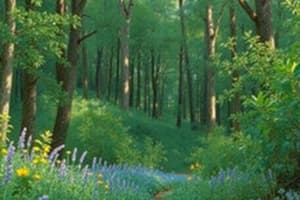Podcast
Questions and Answers
Alin sa mga sumusunod ang karaniwang halimbawa ng mga hayop na matatagpuan sa iba't ibang uri ng mga ekosistemang kagubatan?
Alin sa mga sumusunod ang karaniwang halimbawa ng mga hayop na matatagpuan sa iba't ibang uri ng mga ekosistemang kagubatan?
- Mga daga, kuneho, at buwaya
- Mga uod, butiki, at palaka
- Mga baboy ramo, oso, at ahas
- Mga ibon, insekto, at arachnid (correct)
Ano ang isa sa mga halimbawa ng pagtutulungang makabuluhan (mutualism) na matatagpuan sa mga ekosistemang kagubatan?
Ano ang isa sa mga halimbawa ng pagtutulungang makabuluhan (mutualism) na matatagpuan sa mga ekosistemang kagubatan?
- Ang paggamit ng mga epiphyte sa kanilang host na halaman
- Ang pagkain ng mga predator na hayop sa mga producer na halaman
- Ang paglaban ng mga uri para sa limitadong mga mapagkukunan
- Ang pagpopollinate ng mga bubuyog sa mga bulaklak (correct)
Ano ang isa sa mga epekto ng pagbabago ng klima sa mga ekosistemang kagubatan?
Ano ang isa sa mga epekto ng pagbabago ng klima sa mga ekosistemang kagubatan?
- Pagbaba ng vulnerabilidad sa mga panggigiba tulad ng sunog at mga invasive na species
- Pagbabago sa mga distribution ng mga species at pagtaas ng suscepitibilidad sa mga panggigiba (correct)
- Pagkakaroon ng mas mataas na dami ng mga halaman
- Pagtaas ng bilang ng mga indigenous na hayop
Alin sa mga sumusunod ang isa sa mga halimbawa ng komensalismo na matatagpuan sa mga ekosistemang kagubatan?
Alin sa mga sumusunod ang isa sa mga halimbawa ng komensalismo na matatagpuan sa mga ekosistemang kagubatan?
Bakit mahalaga ang pagmamanage at pagsubaybay sa mga ekosistemang kagubatan sa panahon ng pagbabago ng klima?
Bakit mahalaga ang pagmamanage at pagsubaybay sa mga ekosistemang kagubatan sa panahon ng pagbabago ng klima?
Flashcards are hidden until you start studying
Study Notes
Forest Ecosystems: An Overview of Flora and Fauna
Forest ecosystems play a crucial role in maintaining balance in nature. They consist of complex interactions among various components, including flora (plants), fauna (animals), and other abiotic elements like soil and water. These ecosystems provide essential benefits to humans and support diverse species, contributing significantly to regional biodiversity.
Flora in Forest Ecosystems
The flora component of forest ecosystems includes various types of plants found within these environments. Depending on the specific type of forest—such as temperate, tropical, or boreal—the dominant plant species will differ. Some common examples of flora found in various forest ecosystems include:
- Deciduous trees: Found primarily in temperate forests, deciduous trees lose their leaves seasonally to conserve energy and survive harsh winter conditions. Examples include oak, maple, and birch trees.
- Evergreen conifers: These trees are well-adapted to survive in cold, harsh environments like boreal forests. They include species such as spruce, pine, and fir.
- Understory plants: These small shrubs and herbs grow beneath the canopy of larger trees and play a crucial role in supporting various animals and maintaining soil health.
Fauna in Forest Ecosystems
Forest ecosystems are home to numerous animal species that depend on these habitats for food, shelter, and reproduction. Some common examples of fauna found in different types of forest ecosystems include:
- Mammals: Many mammal species inhabit forests, including predators like bears, wolves, and cougars, as well as smaller creatures such as squirrels, rabbits, and rodents.
- Birds: Forest ecosystems host an array of bird species, from large birds of prey like eagles and hawks to smaller songbirds and woodpeckers.
- Reptiles and amphibians: Snakes, lizards, frogs, and salamanders are among the reptile and amphibian species found in forest ecosystems, particularly in tropical rainforests.
- Insects: Numerous insect species thrive in forest ecosystems, playing essential roles as pollinators and decomposers.
- Arachnids: Spiders and other arachnids make their homes within forest ecosystems, contributing to the overall balance of life within these environments.
Interactions between Flora and Fauna
The flora and fauna in forest ecosystems interact in several ways, creating complex relationships that help maintain ecological equilibrium. For instance:
- Predation: Predacious animals rely on plant producers (such as trees) for food while providing control over herbivorous populations, preventing overconsumption of vegetation.
- Mutualism: Certain organisms have mutually beneficial relationships with others, such as bees pollinating flowers or mycorrhizal fungi assisting with nutrient uptake by tree roots.
- Competition: Different species may compete for limited resources, leading to population fluctuations and potential changes in community composition.
- Commensalism: In some cases, one species benefits from another without affecting it negatively, like mosses growing on tree trunks or epiphytes living off host plants.
Climate Change Impacts on Forest Ecosystems
Climate change poses significant threats to global forest ecosystems, causing shifts in temperature, precipitation patterns, and other environmental factors. This has led to changes in species distributions and increased vulnerability to disturbances, such as wildfires and invasive species. As forest ecosystems adapt to these changes, it is essential to monitor and manage them effectively to minimize negative impacts on both flora and fauna.
Studying That Suits You
Use AI to generate personalized quizzes and flashcards to suit your learning preferences.




